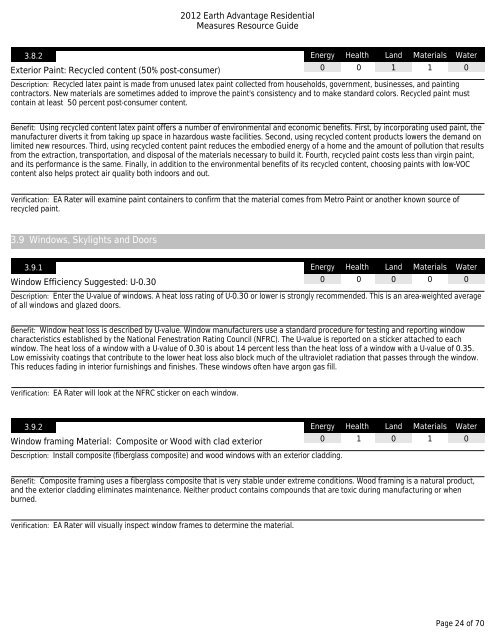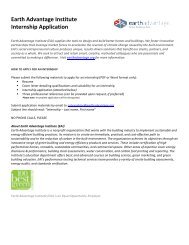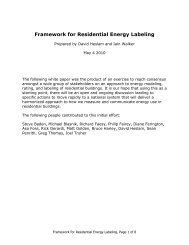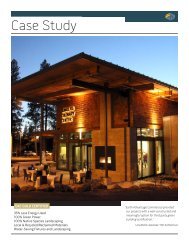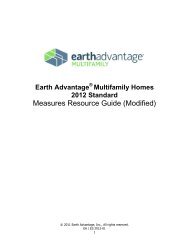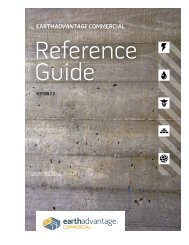EA New Homes Measures Guide - Earth Advantage
EA New Homes Measures Guide - Earth Advantage
EA New Homes Measures Guide - Earth Advantage
Create successful ePaper yourself
Turn your PDF publications into a flip-book with our unique Google optimized e-Paper software.
2012 <strong>Earth</strong> <strong>Advantage</strong> Residential<br />
<strong>Measures</strong> Resource <strong>Guide</strong><br />
3.8.2<br />
Exterior Paint: Recycled content (50% post-consumer)<br />
Energy<br />
Health<br />
Materials<br />
Water<br />
0 0 1 1 0<br />
Description: Recycled latex paint is made from unused latex paint collected from households, government, businesses, and painting<br />
contractors. <strong>New</strong> materials are sometimes added to improve the paint's consistency and to make standard colors. Recycled paint must<br />
contain at least 50 percent post-consumer content.<br />
Land<br />
Benefit: Using recycled content latex paint offers a number of environmental and economic benefits. First, by incorporating used paint, the<br />
manufacturer diverts it from taking up space in hazardous waste facilities. Second, using recycled content products lowers the demand on<br />
limited new resources. Third, using recycled content paint reduces the embodied energy of a home and the amount of pollution that results<br />
from the extraction, transportation, and disposal of the materials necessary to build it. Fourth, recycled paint costs less than virgin paint,<br />
and its performance is the same. Finally, in addition to the environmental benefits of its recycled content, choosing paints with low-VOC<br />
content also helps protect air quality both indoors and out.<br />
Verification: <strong>EA</strong> Rater will examine paint containers to confirm that the material comes from Metro Paint or another known source of<br />
recycled paint.<br />
3.9 Windows, Skylights and Doors<br />
3.9.1<br />
Window Efficiency Suggested: U-0.30<br />
Energy<br />
Materials<br />
Water<br />
0 0 0 0 0<br />
Description: Enter the U-value of windows. A heat loss rating of U-0.30 or lower is strongly recommended. This is an area-weighted average<br />
of all windows and glazed doors.<br />
Health<br />
Land<br />
Benefit: Window heat loss is described by U-value. Window manufacturers use a standard procedure for testing and reporting window<br />
characteristics established by the National Fenestration Rating Council (NFRC). The U-value is reported on a sticker attached to each<br />
window. The heat loss of a window with a U-value of 0.30 is about 14 percent less than the heat loss of a window with a U-value of 0.35.<br />
Low emissivity coatings that contribute to the lower heat loss also block much of the ultraviolet radiation that passes through the window.<br />
This reduces fading in interior furnishings and finishes. These windows often have argon gas fill.<br />
Verification: <strong>EA</strong> Rater will look at the NFRC sticker on each window.<br />
3.9.2<br />
Energy Health Land Materials Water<br />
Window framing Material: Composite or Wood with clad exterior<br />
0 1 0 1 0<br />
Description: Install composite (fiberglass composite) and wood windows with an exterior cladding.<br />
Benefit: Composite framing uses a fiberglass composite that is very stable under extreme conditions. Wood framing is a natural product,<br />
and the exterior cladding eliminates maintenance. Neither product contains compounds that are toxic during manufacturing or when<br />
burned.<br />
Verification: <strong>EA</strong> Rater will visually inspect window frames to determine the material.<br />
Page 24 of 70


